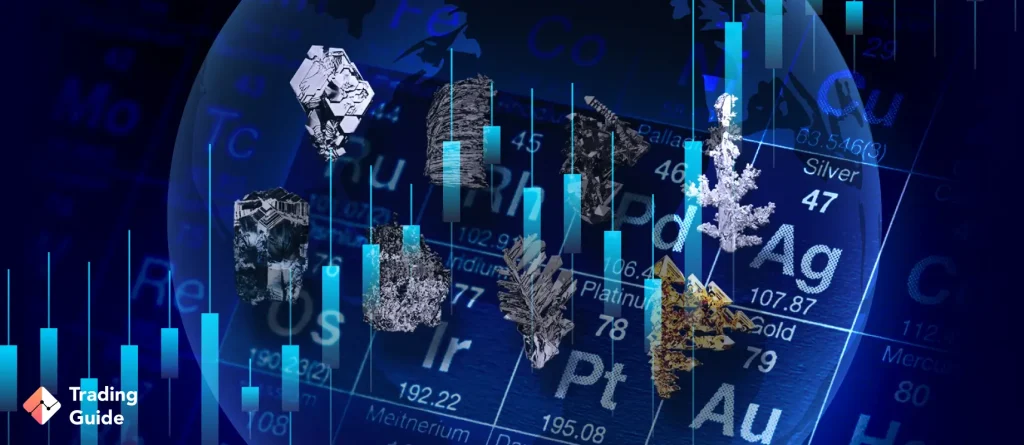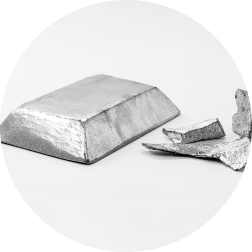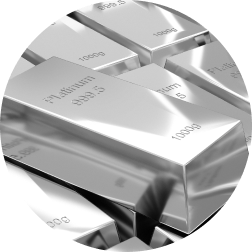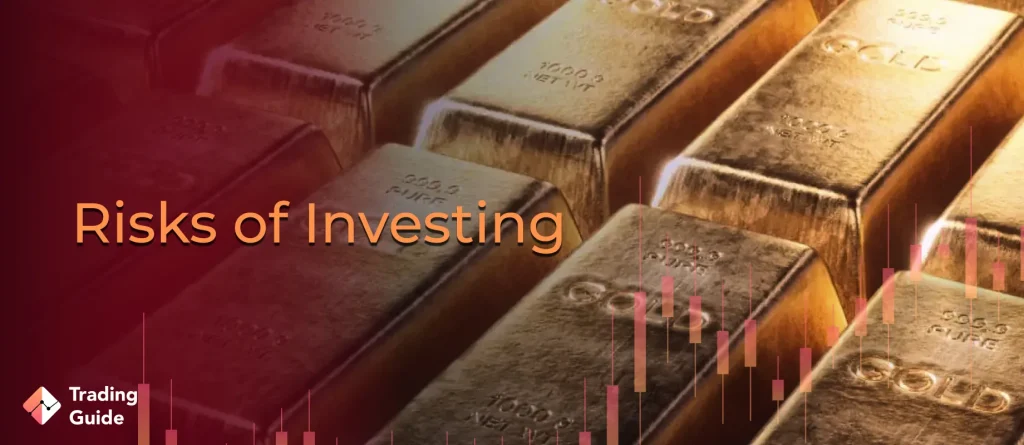Precious metals like gold were once reserved for the ultra-wealthy who could afford them. Back then, investors were only allowed to purchase considerable quantities of these assets in physical form. Times have changed; today, anyone can buy precious metals. Many dealers and platforms give investors the opportunity to get started with as little as £10.
If you’re interested in trading or buying precious metals, read this guide first. I’ve covered everything you need to know and shared expert insights. You’ll discover everything from the meaning of precious metals to the must-know risks of investing in these assets.
In This Guide
What Are Precious Metals? A Complete Guide for Investors
What Are Precious Metals?

Let’s kick off with one of the most critical questions: What are precious metals?
Precious metals are a group of highly valued metallic elements that possess unique characteristics and properties. Common examples include gold, silver, platinum, and palladium. These metals are sought after for their rarity, durability, and aesthetic appeal. They have been treasured by civilisations for centuries and are considered to be of great worth in various industries and investment portfolios.
One of the defining features of precious metals is their limited supply. They are relatively scarce in nature, making them inherently valuable. Their scarcity, combined with their beauty and resistance to corrosion, makes them suitable for jewellery production, decorative arts, and luxury goods.
A good example of a scarce precious metal, which is found at a rate of approximately 0.0004 parts per million in the Earth’s crust. Simply put, there are only around 0.004 parts of gold in every 1 million parts of rock and soil.
In the investment realm, precious metals serve as a store of value and a hedge against economic uncertainties. They provide a tangible asset that can protect against inflation and market volatility. Seasoned investors like myself often include precious metals in their portfolios to diversify risk and preserve wealth over the long term.
How to Invest in Precious Metals: Step-by-Step
Trading commodities carries risks such as market volatility, leveraged positions, and the potential for substantial losses. To manage these risks, diversify your investments, use stop-loss and take-profit orders, and trade with funds you can afford to lose. Additionally, stay informed about market factors, adhere to a well-defined trading plan, and guard against emotional decision-making.
It is also crucial to comply with market regulations and be cautious of counterparty risk. Regularly reassessing your risk tolerance and trading strategies will help you trade responsibly and maximise profitability.
Gone are the days when investing in precious metals required buying actual bars or coins and stashing them in a safe. In the digital age, you can go the conventional route by buying expensive metals from trusted dealers or opt for ETFs that track the prices of your favourite assets. For instance, you can invest in gold-backed ETFs that allow you to track the price of gold without having to buy ingots, coins, etc.
What’s more, thanks to a variety of investment apps, you can buy a claim backed by tangible assets held in pooled accounts and cash out whenever you please. That saves you the hassle of owning and storing physical metals. Not to forget, many precious metals trading sites offer you the opportunity to trade CFDs on gold, silver, and many other assets.
I’ve been investing in precious metals for a long time. Here’s a distilled version of the steps I often follow:
Before doing anything else, ask yourself why you’re investing in precious metals. Is it to hedge against inflation, diversify your portfolio, or are you simply searching for a safe-haven asset? You need clear objectives to do everything else, from picking the right metals to invest in to identifying the most suitable dealer.
I discourage diving in without clear objectives for multiple reasons. For starters, you will be more likely to buy the wrong assets while focusing on factors like cheapness. That is a mistake many novices make, and it often leads to unwarranted frustration and disappointment.
Gold is a favourite for many investors, including yours truly. I prefer this precious metal because it has maintained its value and reputation as a safe-haven asset for a long time. Plus, it’s recognised worldwide and is highly liquid. That said, there are many other precious metals you can invest in, including silver, platinum, and palladium.
When selecting the right assets to invest in, consider your investment objectives. For instance, if your goal is wealth preservation, gold should be on your must-consider list, as it tends to maintain its value even in times of crisis, recession, and inflation. You should also factor in your risk tolerance, market demand, and the long-term performance history of every available asset.
I previously highlighted the most common ways to invest in precious metals. To recap, the available options include bullion, exchange-traded funds (ETFs), and digital assets. Evaluate each investment method’s benefits, risks, and level of involvement before committing. Most importantly, pay close attention to your investment goals and preferences.
If you want to own physical metals, investing in bullion should be your go-to. However, if you wish to gain exposure to your favourite assets without the hassle of managing storage, consider ETFs or digital assets. Don’t forget about investment time horizon, storage needs, and tax implications.
If you choose to invest in bullions, buy from reputable dealers. Look for service providers with a solid reputation and a long-standing presence. Before trusting any entity, check its reviews and ratings on independent sites like Trustpilot and Google Maps. Also, verify that your chosen dealer offers the precious metals you need before making a commitment.
Supposing you choose ETFs or digital claims, you’ll need to find credible, regulated brokers. Your trust should be in service providers that are authorised and regulated by the Financial Conduct Authority (FCA) and other respected regulatory bodies. To avoid losing your hard-earned capital, don’t invest with companies that are not licensed and regulated by known authorities. Also, gauge every service provider’s online reputation, costs, and support service.
Sign up with your chosen service provider and either fund your account or link a payment method. Then check out the available precious metals and pick the right one to start with. If you’re a total newbie, I advise starting small rather than risking every cent from the outset. Most importantly, stick to your plan.
After investing, keep a close eye on market conditions, even if you plan to hold a specific precious metal for an extended period. That is the best way to ensure you spot opportunities and risks as early as possible. With a clear idea of what’s happening in the market, you will be in the best position to identify when it’s the right time to rebalance your portfolio or make a strategic exit.
Investing in the Most Popular Precious Metals
As a seasoned investor, I’ve come to one crucial realisation: precious metals aren’t one-size-fits-all investments. Investors have to put their money in the right assets to reap maximum returns. And each option available today comes with unique opportunities, risks, and characteristics.
To help you choose suitable assets, I have highlighted everything you need to know about the most popular precious metals below.
1. Gold

Based on what I’ve learned over the years, gold is the most well-known and revered of all precious metals. Its enduring allure stems from its scarcity, malleability, and resistance to corrosion. This metal has been a symbol of wealth and power across cultures and civilisations. Investors are drawn to it for its ability to preserve value during times of economic uncertainty and inflation.
Gold serves as a hedge against currency fluctuations and acts as a store of wealth. The asset is commonly traded in the form of bars, coins, and even jewellery. Additionally, gold finds use in various industries, including electronics, dentistry, and aerospace. Before investing in gold, note that a variety of factors can cause the price of this metal to fluctuate significantly, including geopolitical conflicts and shifts in market sentiment.
Read about the gold trading in the UK and commodity brokers in the UK in our other comprehensive guides.
2. Silver

Like gold, Silver holds a unique place among precious metals due to its affordability, industrial applications, and historical role as a currency. While silver is valued for its aesthetic appeal in jewellery and silverware, it also possesses excellent thermal and electrical conductivity. As a result, silver is widely used in electronics, solar panels, and the automotive industry.
Silver’s relatively lower price compared to gold makes it accessible to global investors, allowing for potential diversification within precious metal portfolios. That said, this precious commodity is more volatile than its biggest competitor, gold. Its high volatility is caused primarily by significant industrial demand. Silver is used in industry and manufacturing more than gold.
3. Palladium

Palladium’s popularity is primarily driven by its crucial role in the automotive industry. This lustrous white metal is used in catalytic converters to reduce harmful vehicle emissions. The increasing global focus on environmental regulations and the demand for cleaner emissions have propelled palladium prices to record highs.
Investors are drawn to Palladium for its industrial applications and potential for capital appreciation. However, it’s important to note that palladium is a niche market, and its price can be highly volatile. This precious metal has lower investment demand, which is why it’s cheaper than gold despite being rarer.
4. Platinum

Like its precious metal counterparts, Platinum possesses remarkable physical properties, including resistance to corrosion and high melting points. It finds extensive use in automotive manufacturing, jewellery, and chemical refining industries. Platinum is particularly sought after in the production of catalytic converters, where it helps reduce emissions from internal combustion engines.
In addition to its industrial significance, platinum also holds investment appeal. Its relatively limited supply and diverse applications contribute to its value as an investment asset. Platinum is rarer than both gold and silver. With that in mind, the prices of this precious metal often fluctuate in response to changing industrial demand, among other factors.
Read a comprehensive IronFX review in our other article.
Risks of Investing in Precious Metals

Risk-free investing is a fallacy; take that from me, a seasoned investor and analyst. That applies everywhere, including where precious metals are involved. While investing in assets like gold and silver, you will be exposed to numerous risks and shortcomings, including:
- Price volatility: Despite being referred to as safe havens, precious metals are subject to price fluctuations. The value of your chosen assets can rise or dip by a significant margin within a short time for a variety of reasons, including global economic shifts and geopolitical tensions.
- Theft and damage: Bullion demands physical storage. You can store physical metals in a high-quality safe at home or leave them in a bank safety deposit box. Or, you can designate storage to professional service providers. Either way, while in storage, physical assets can be stolen or damaged by harsh elements.
- Lack of yield: Unlike conventional alternatives like stocks and bonds, precious metals don’t pay yield or dividends. That makes them the least ideal options for investors looking for consistent income. The only way to earn from these assets is by selling after price appreciation.
- Low liquidity: Platinum and palladium are often associated with low liquidity. They are harder to sell, especially in bullion form. These assets have lower liquidity than their counterparts because they are lesser-known metals with niche industrial demand.
FAQs
Rhodium is the most expensive precious metal today, with an ounce costing thousands of pounds.
The most valuable metal on Earth is Rhodium. It trades at much higher prices per ounce than its counterparts, including gold.
There are traditionally 8 elements in the list of precious metals, including gold, silver, platinum, palladium, rhodium, ruthenium, iridium, and osmium. These metals have been valued for their unique properties, durability, and various industrial uses throughout history.
The best way to invest in precious metals is by purchasing the assets to sell later for profits. If you do not want to go through the hassle of looking for secure storage for your assets, consider investing in precious metals through derivative trading. This can be through CFDs, ETFs, futures contracts, etc. You can also invest in mining companies’ shares.
Yes, you can own physical precious metals, such as gold, palladium, and silver. They come in the form of bullion, which is essentially bars and coins.




Excellent guide that covers the fundamentals really well. I've been trading precious metals alongside forex and crypto for about four years now, and I can confirm everything here aligns with my experience. The point about defining your objectives first is absolutely critical - I initially jumped into silver just because it was cheaper than gold, and that mindset cost me when industrial demand dropped and prices tanked faster than I expected.